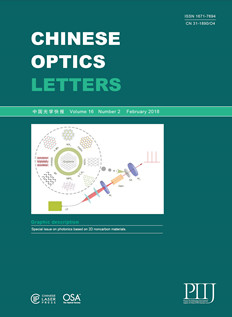- Special Issue
- Photonics based on 2D noncarbon materials
- 20 Article (s)
- Publication Date: Feb. 10, 2018
- Vol. 16, Issue 2, 020001 (2018)
- Publication Date: Feb. 10, 2018
- Vol. 16, Issue 2, 020002 (2018)
- Publication Date: Feb. 10, 2018
- Vol. 16, Issue 2, 020003 (2018)
- Publication Date: Feb. 10, 2018
- Vol. 16, Issue 2, 020004 (2018)
- Publication Date: Feb. 10, 2018
- Vol. 16, Issue 2, 020005 (2018)
- Publication Date: Feb. 10, 2018
- Vol. 16, Issue 2, 020006 (2018)
- Publication Date: Feb. 10, 2018
- Vol. 16, Issue 2, 020007 (2018)
- Publication Date: Feb. 10, 2018
- Vol. 16, Issue 2, 020008 (2018)
- Publication Date: Feb. 10, 2018
- Vol. 16, Issue 2, 020009 (2018)
- Publication Date: Feb. 10, 2018
- Vol. 16, Issue 2, 020010 (2018)
Two-dimensional (2D) noncarbon materials with outstanding optical properties are catching worldwide attentions on the heels of the discovery of graphene. Besides the large 2D family of transition metal dichalcogenides (TMDs), a series of new kind of mono-elemental 2D noncarbon materials, such as phosphorene, arsenene, antimonene and silicene, were recently emerging. The mentioned mono-elemental 2D materials shows unique properties like light emitting, non-linear optics, ultrafast optics, bio-related photonics and etc. The potential applications of these materials are in laser, ultrafast phtonics, biophotonics, optical modulation and optical devices. The scope of this special focus, covers all aspects of experimental research related to 2D noncarbon materials beyond graphene for optics, photonics and optoelectronics.










